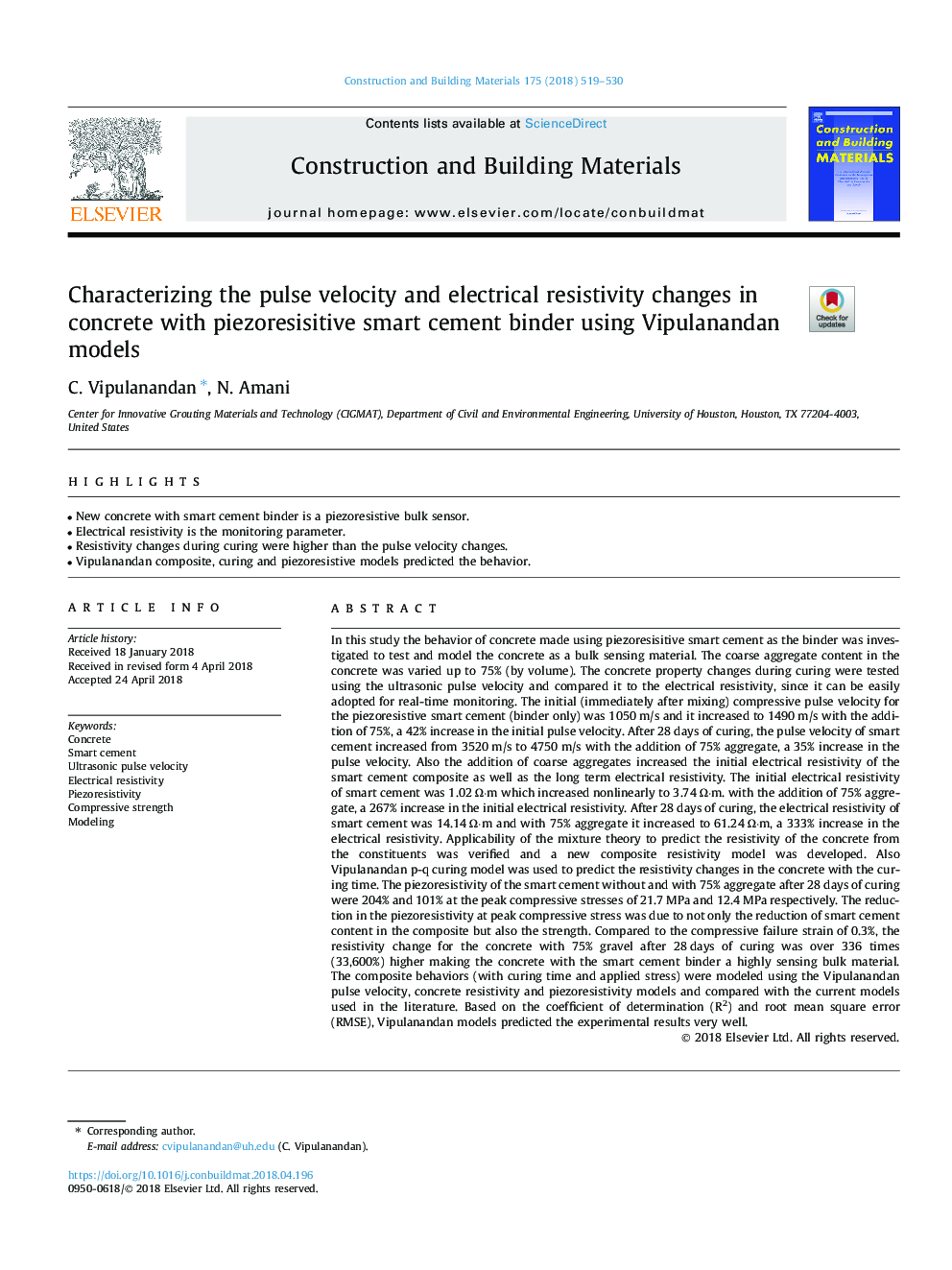| کد مقاله | کد نشریه | سال انتشار | مقاله انگلیسی | نسخه تمام متن |
|---|---|---|---|---|
| 6713587 | 1428731 | 2018 | 12 صفحه PDF | دانلود رایگان |
عنوان انگلیسی مقاله ISI
Characterizing the pulse velocity and electrical resistivity changes in concrete with piezoresisitive smart cement binder using Vipulanandan models
دانلود مقاله + سفارش ترجمه
دانلود مقاله ISI انگلیسی
رایگان برای ایرانیان
کلمات کلیدی
موضوعات مرتبط
مهندسی و علوم پایه
سایر رشته های مهندسی
مهندسی عمران و سازه
پیش نمایش صفحه اول مقاله

چکیده انگلیسی
In this study the behavior of concrete made using piezoresisitive smart cement as the binder was investigated to test and model the concrete as a bulk sensing material. The coarse aggregate content in the concrete was varied up to 75% (by volume). The concrete property changes during curing were tested using the ultrasonic pulse velocity and compared it to the electrical resistivity, since it can be easily adopted for real-time monitoring. The initial (immediately after mixing) compressive pulse velocity for the piezoresistive smart cement (binder only) was 1050â¯m/s and it increased to 1490â¯m/s with the addition of 75%, a 42% increase in the initial pulse velocity. After 28â¯days of curing, the pulse velocity of smart cement increased from 3520â¯m/s to 4750â¯m/s with the addition of 75% aggregate, a 35% increase in the pulse velocity. Also the addition of coarse aggregates increased the initial electrical resistivity of the smart cement composite as well as the long term electrical resistivity. The initial electrical resistivity of smart cement was 1.02â¯Î©Â·m which increased nonlinearly to 3.74â¯Î©Â·m. with the addition of 75% aggregate, a 267% increase in the initial electrical resistivity. After 28â¯days of curing, the electrical resistivity of smart cement was 14.14â¯Î©Â·m and with 75% aggregate it increased to 61.24â¯Î©Â·m, a 333% increase in the electrical resistivity. Applicability of the mixture theory to predict the resistivity of the concrete from the constituents was verified and a new composite resistivity model was developed. Also Vipulanandan p-q curing model was used to predict the resistivity changes in the concrete with the curing time. The piezoresistivity of the smart cement without and with 75% aggregate after 28â¯days of curing were 204% and 101% at the peak compressive stresses of 21.7â¯MPa and 12.4â¯MPa respectively. The reduction in the piezoresistivity at peak compressive stress was due to not only the reduction of smart cement content in the composite but also the strength. Compared to the compressive failure strain of 0.3%, the resistivity change for the concrete with 75% gravel after 28â¯days of curing was over 336 times (33,600%) higher making the concrete with the smart cement binder a highly sensing bulk material. The composite behaviors (with curing time and applied stress) were modeled using the Vipulanandan pulse velocity, concrete resistivity and piezoresistivity models and compared with the current models used in the literature. Based on the coefficient of determination (R2) and root mean square error (RMSE), Vipulanandan models predicted the experimental results very well.
ناشر
Database: Elsevier - ScienceDirect (ساینس دایرکت)
Journal: Construction and Building Materials - Volume 175, 30 June 2018, Pages 519-530
Journal: Construction and Building Materials - Volume 175, 30 June 2018, Pages 519-530
نویسندگان
C. Vipulanandan, N. Amani,